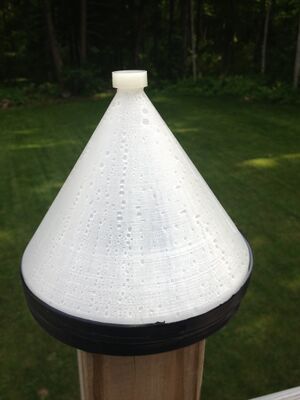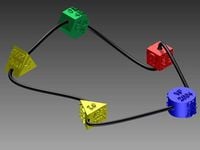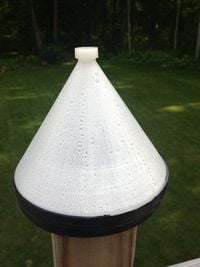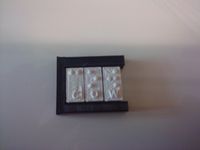
| 3D Printing in Albania |
|---|
What is the Printers for Peace Contest?[edit | edit source]
We are challenging the 3D printing community to design things that advance the cause of peace. This is an open-ended contest, but if you’d like some ideas, ask yourself what Mother Theresa, Martin Luther King, or Gandhi would make if they’d had access to 3D printing.
- low-cost medical devices
- tools to help pull people out of poverty
- designs that can reduce racial conflict
- objects to improve energy efficiency or renewable energy sources to reduce wars over oil
- tools that would reduce military conflict and spending while making us all safer and more secure
- things that boost sustainable economic development (e.g. designs for appropriate technology in the developing world to reduce scarcity)
Prizes:
A fully assembled Type A Machines Series 1 3D Printer goes to first place. Fully assembled, open-source Type A Machines Series 1 3D Printer The Series 1 recently won best in class in the Make: Ultimate Guide to 3-D Printing. It has a 9-by-9-by-9-inch build volume, prints at 90mm/sec in PLA, ABS and PVA with 0.1mm resolution.
MOST RepRap 3D printer kit will go to the second prize winner who create designs that enable 3D printers to encourage peace. Michigan Tech’s MOST version of the RepRap Prusa Mendel open-source 3D printer kit can be built in a weekend. It has a 7.8–by-7.8-by-6.8-inch build volume on a heated bed, prints comfortably at 80 mm/sec ABS, 45 mm/sec PLA, HDPE and PVA with 0.1 mm resolution.
Third prize is a MatterHackers sampler pack MatterHackers sampler pack of 3-D printer materials of 3 PRO Series PLA spools, Laywoo-D3, Nylon, and Soft PLA.
See:full contest details - Deadline Sept 1, 2013
For examples on Appropedia see Open source 3-D printing of OSAT
Sponsors[edit | edit source]
Michigan Tech has already saved tens of thousands of dollars using 3D printable scientific and engineering equipment. Our labs have developed 3D printable tools to test water quality, recycle waste plastic and found that 3D printing consumer goods is better for the environment than shipping them from China. The technological evolution of 3D printers, widespread Internet access, and inexpensive computing offer new opportunities for open design to enable peaceful and accelerate wealth creation for everyone.
Our goal is to facilitate an open exchange of 3-D designs of technologies that benefit humanity.
- The Michigan Tech Department of Electrical and Computer Engineering
- The Michigan Tech Department of Materials Science and Engineering
- Type A Machines
- MatterHackers
Winners[edit | edit source]

1st Prize went to John Van Tuyl from Hamilton, On who designed VaxBeads, which are 3-D printed immunization records. VaxBeads offer the potential to ease the determination of what vaccines a child needs in the developing world. Each bead represents a different vaccine. The shape and colour of each bead is unique to a specific vaccine.
This innovative idea showcased the ability of 3-D printing as each bead is customized on the spot with the child's initials, date of birth, and an identifying number. It is the designer's hopes that the beads would have more intrinsic value to the patients than standard vaccination cards.

2nd prize (Michigan Tech’s MOST version of the RepRap Prusa Mendel open-source 3D printer kit) went to Michigan Tech student, Matt Courchaine, for his Solar Powered Water Purification Cone. In disaster areas or among the millions of people that do not have improved water supplies clean water is a precious commodity. This printable design allows users to make clean water from contaminated supplies. The white, semi-transparent plastic cover of the solar cone allows sunlight to pass through it and evaporate dirty water contained in the black base tray. Clean water then condenses on the cooler white plastic of the cone and drips into a holding reservoir, which is part of the cone for later drinking.

3rd prize was awarded to Aaron Meidinger for the design of a Braille Tablet, which is a tool for a sighted person to help a blind person to learn braille or just a quick way to leave a note for a friend. One print out a braille platform and a scrabble set of letters, along with some of the punctuation and a nice pile of blank tiles to use it to write any short message.
All the open-source entries to the contest demonstrated the technical ability and promise of low-cost 3-D printers to provide for humanities needs and advance the cause of peace.
Similar Projects on Appropedia[edit | edit source]
Media Coverage[edit | edit source]
Pre-Award[edit | edit source]
- 3D Printing World Peace - 3D Printing Industry
- 3D Printers for Peace competition seeks ideas that 'benefit humanity' - Wired UK
- Inventors Challenged in 3D Printers for Peace Contest - International Business Times
- An Interview With Dr. Joshua Pearce Of Printers For Peace - TechCrunch
- Forschungswettbewerb: Drucken für den Frieden - Spiegel Online, which is the sibling of Germany's print weekly Der Spiegel
- Contest: design peaceful uses for 3D printers - Boing-Boing
- Michigan Tech Sponsors A 3D Printers For Peace Contest - TechCrunch
- 3D Printers for Peace - CBS Detroit
- Michigan Tech Launches 3D Printers for Peace Contest - MTU News, 3Ders, 3D Printer World
- Rapid Ready Roundup: State Department, Printers for Peace, Food and Star Trek - Rapid Ready Tech
- What would Jesus print? 3D Printers for Peace design contest responds to 3D printer gun - AL
- First 3D Printers for Peace Contest - Textually
- 3D Printers For Peace Contest - Slashdot
- Michigan Tech's 3D Printers for Peace - Fabbaloo
- Michigan Tech Sponsors A 3D Printers For Peace Contest - Gadget Blog
- Reddit [1],
- 3D Printers For Peace - LiDAR News
- 3D Printers for Peace Contest aims to challenge negative perceptions of the technology - Yahoo News Canada
- 3D Printers for Peace with Michigan Tech - Type A Machines Blog
- 3D Printing for Peace - Things are Good
- WCFT-TV ABC in Birmingham, Ala
- TV6 - Fox UP
- WWJ Newsradio 950–2013/05/12
- 3D Printers for Peace - Make
- Imprimantes 3D et un "Concours pour La Paix" - Huffingtonpost (French)
- 3D Printers Unite For Goodwill & Rad 3D Printing Tools Via Printers for Peace Contest - Inventor Spot
- 3D Printers for Peace - 3D Geeks
- 3D Printers for Peace - SciTechConnect
- 3D Printing Adventure in Albania (video) - 3Ders
Post Award[edit | edit source]
- Immunization Beads Garner Top Prize in 3D Printers for Peace Contest - MTU News, TG Daily, 3Ders, Keweena Now, World News Views
- “3D Printers for Peace” Contest — The Results are In - 3D Printing Industry
- VaxBeads Wins 3D Printers for Peace Contest - Rapid Ready Tech
- Immunization Beads Garner Top Prize in 3D Printers for Peace Contest - Detroit CBS, Detroit City and Press
- Executive Interview — Espen Sivertsen, CEO of Type A Machines - 3D Printing Industry
- First 3-D Printers for Peace Prize Awarded - The Keweenaw Report airs each weekday morning, noon and afternoon on 97.7 the Wolf, KBear 102.3, and AM 1400, WCCY.
- Winner in 3D printer contest designs vaccination record system - TV6 Fox UP
- 3D Printers for Peace Announces 2013 Winners -3D Printer World
- Immunisation beads get top prize in 3D Printers for Peace contest - Computer Business Review
- 3DPI Writer, Mike Molitch-Hou’s Top 5 3D Printing Applications of 2013


